Menus
- One of a kind
- V-Twin demodue, 904 cm3, 75 hp and 76 Nm, 186 kg dry, 2,000 copies produced
- Genesis
- Discovery
- In the saddle
- Test
- Conclusion
One of a kind
V-Twin demodue, 904 cm3, 75 hp and 76 Nm, 186 kg dry, 2,000 copies produced
You know you’ve been successful as a motorcycle designer when one of your colleagues praises your work – and better yet – takes inspiration from it to produce his own variation on a similar theme.. This is what happened to South African Pierre Terblanche 20 years after creating his famous Ducati MH900e neo-retro. The 900 MH900e was the fascinating combination of old and new, conceived as an anniversary, for his 10 years at the helm of Ducati design. Production will follow in December 2000.
The now ex-design director of MV Agusta Adrian Morton then credits him with the genesis of his sensual Superveloce 800:
I really like the Ducati MH900e that my friend Pierre Terblanche designed in 2000. When I saw this bike for the first time, it really touched me in terms of design. Because it was not retro, but not modern either. She managed to capture the balance between the future and the past in a new way. We tried to do the same with the Superveloce.
 Test drive of the sports car Ducati MH900e
Test drive of the sports car Ducati MH900e
But, was she beautiful or horrible? Beautiful or downright divine? We certainly couldn’t remain indifferent to Terblanche’s MH900e showbike when it first appeared at Intermot 1998. It was a bike that we loved or hated the first time we laid eyes on it, which divided opinion to a point that few motorcycles have reached (apart from perhaps the 1995 Bimota DB3 Mantra). The creation of Terblanche thus fulfilled its presumed objective, to make speak about it, thus creating a new prestige for the Ducati brand as a whole while drawing attention to it. For a showbike, the contract was fulfilled !
Genesis
Yes, but this is just a concept, fervent MHe admirers around the world thought, surely we will never be able to buy one? Well, Ducati was so overwhelmed by the feedback, which even led to the crash of its website, to what initially was to be a one-off creation, that the decision to build a limited and numbered edition of 1000 copies. was quickly taken. It soon became clear that this would not be enough. And for the Bologna Motor Show in December 1999, Ducati had already doubled this number to meet demand.
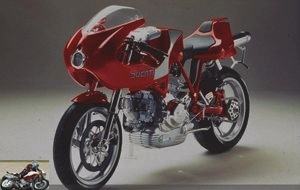 The MH900e concept presented at Intermot 1998
The MH900e concept presented at Intermot 1998
In addition, the MH900e, for "evoluzione", would be the first motorcycle to be sold exclusively on the internet. Each of the 2000 motorcycles manufactured being sold at a price of 15,000 €, regardless of the country in which we were. The success was immediate when the dedicated site opened, the first 1000 models leaving in just 31 minutes, the others in the following twelve hours with around 38% of buyers in Japan, 30% in Europe, 30% in the States. United and the rest in Australia and South America. Once the order was confirmed, the customer could follow the progress of the construction of his MH900e on the internet before it was sent to the nearest dealer..
Inevitably, the MH900e quickly rose to object of desire status, leaving a horde of unsatisfied potential buyers, with machines confirmed to be sold at high prices on the web … Ducati even published a book called Aooh! Ch’e ‘sto net? Manname ‘na moto! (which can roughly be translated as "Hey! What the hell the net? Just give me the bike!"), a collection of posts from various sources, ranging from those who were quick enough to attach their name to the bike, to others who weren’t so lucky, as well as those who preferred to admire, or draw, from afar. Like the motorcycle, the book was naturally only available via the Ducati website..
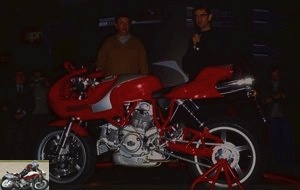 Pierre Terblanche and Ducati CEO Federico Minoli at the launch of the production MH900e at the Bolognas Motor Show 1999
Pierre Terblanche and Ducati CEO Federico Minoli at the launch of the production MH900e at the Bolognas Motor Show 1999
Production of the MH900e was originally scheduled to be outsourced to Bimota and start in June 2000. But the collapse of the small Rimini company in April prompted Ducati to find space in its Bologna plant for the handcrafted manufacture of a motorcycle which, by definition, could not be assembled on the usual production lines. This is why the construction of the 2000 motorcycles did not finally begin until December 2000, a year after the launch, with equipment assembling the machines in batches of 50 to deliver them all over the world. About five motorcycles were produced each day, a relatively slow pace which explains why the 2000 promised units were not finally finished to be produced until 2002. !
The MH900e concept has been able to link the different sides of motorcycle history by using modern technology, selling it through tomorrow’s marketing and relying on the style of yesterday’s designs. Recall that MH represented Mike Hailwood, winner of one of Ducati’s two most famous successes, on the Isle of Man during the 1978 Formula 1 TT and whose bike was the starting point for Pierre Terblanche’s design work..
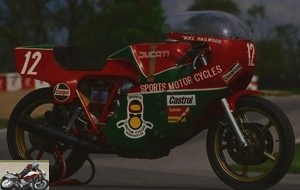 Mike Hailwood’s 1978 Ducati 900 TT1 NCR
Mike Hailwood’s 1978 Ducati 900 TT1 NCR
The production version was a relatively faithful replica of Intermot’s concept bike. Moreover, Ducati made the curious choice to put this original prototype up for auction at the Sotheby’s sale in Chicago in September 1999. If it did not reach its reserve price of $ 1 million, the prototype went up to ‘to $ 750,000. Another good advertisement for the one you could buy for a fraction of that amount.
Equally oddly, Ducati, which was under American control at the time, should have been more conscientious on the issue of copyright. It emerged some time later that the brand had not contacted Pauline Hailwood, Mike’s widow, or his son David to obtain agreement to use the pilot’s name in their MH900e. No provision had therefore been made to remunerate the beneficiaries on the sales of each model. In 2001, Ducati was attacked by Pauline for the misuse of Mike Hailwood’s name and made an original defense by arguing that the MH900e was simply "inspired by the Ducati motorcycle that Mike Hailwood rode in the 1978 Tourist Trophy" . The case was settled confidentially, with Pauline granting the company a retroactive license, presumably on the basis of financial compensation..
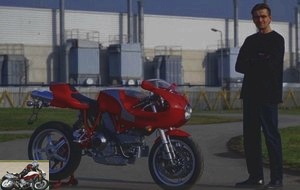 Pierre Terblanche alongside his creation
Pierre Terblanche alongside his creation
Discovery
While the production version retains the metallic coating of the prototype around the engine, in order to give the impression that it is powered by a 70s desmo V-twin engine similar to the one that drove Mike’s bike to victory. in the TT, it is in fact the same Desmodue engine with single overhead camshaft, injection, air cooling, belt drive and 6-speed gearbox as the contemporary 900SS and Monster, producing only 75 horsepower at 8,000 rpm in its MH900e form. That’s 4 horsepower less than the 900SS due to the more restrictive exhaust system, with maximum torque of 76 Nm at 6,250 rpm.
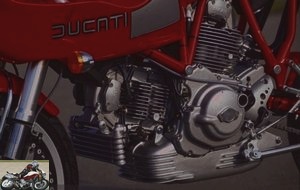 Under its 70’s appearances, it is indeed the Desmodue of the 900SS
Under its 70’s appearances, it is indeed the Desmodue of the 900SS
In many ways, Terblanche’s original design achieves the difficult feat of preserving futurism and retro. Here it rests on a Chrome-Moly steel trellis frame designed so that the engine can be seen as far as possible from either side. The result is a rather tall bike with a saddle at 825mm that feels even higher, so even a 6’8 rider can only tiptoe at a red light. With its 1m93, its designer should not have the same problem. He admitted later that it was a motorcycle he dreamed of building for himself….
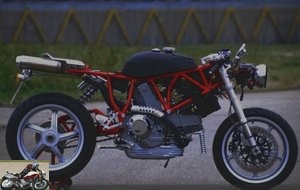 The MHe is based on a perimeter lattice frame
The MHe is based on a perimeter lattice frame
The shortened saddle with double exhausts is a feature of the model, as is the pointed nose half-fairing that mixes with the fuel tank, reminiscent of the one-piece saddle / tank unit of the Ducati of Hailwood which was then topped with the Ducati logo designed by automotive designer Giugiaro.
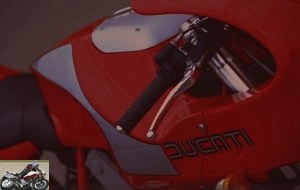 The sports car uses the Ducati logo of the seventies
The sports car uses the Ducati logo of the seventies
The intricately shaped tubular trellis single-sided swingarm is a true work of art, a clever and even modern reinterpretation of the Ducati trademark with period materials. For many it was the most admirable element of the bike, a masterpiece of tube bending and metalwork, incorporating the shift of the direct acting Paioli mono shock to the left..
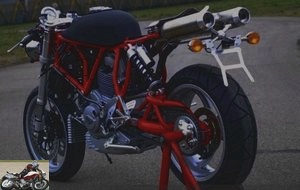 The truss single-arm is a true work of art
The truss single-arm is a true work of art
The Machesini wheels are unique to the MH900e and identical to those fitted to the Intermot proto. But we now find two Brembo front discs of 320 mm mounted on the 17-inch wheels instead of the sole avant-garde disc of the prototype whose material was not yet approved for the road..
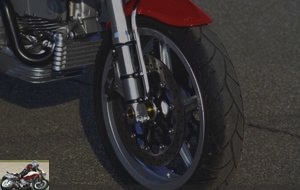 The production version receives two Brembo calipers, compared to only one on the proto
The production version receives two Brembo calipers, compared to only one on the proto
There are other minor differences with the concept such as the rear indicators moved from the inside of the silencers to a separate position below, the wider front headlight for homologation reasons, the conventional key instead of the magnetic card, the absence of a half-crankcase exposing the clutch due to European restrictions and finally the brake light came to be placed in place of the camera which monitored the area behind the pilot.
 The production model has some differences, mainly for homologation reasons
The production model has some differences, mainly for homologation reasons
In the saddle
I had the opportunity to drive the pre-production prototype of the MH900e, stamped with the number 0000/2000. The number was placed on a silver plaque atop the tank trim wrapped around a tiny plastic fuel reserve of just 8.5 liters.
I remember that day, a frosty day in January 2001. The mercury was painfully above zero. However, these conditions allowed me to discover some good surprises. First of all, this is a much better performance road bike than most people expected..
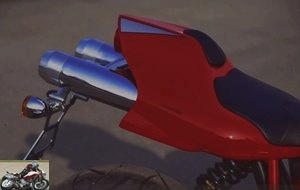 The saddle of the Ducati MH900e
The saddle of the Ducati MH900e
The height of the bike is its only major downside, even for someone whose height is usually not a concern like me. I don’t know how the 38% of buyers residing in Japan managed to deal with a motorcycle they had never been able to sit on before ordering it…
The proportions of the MH900e are quite different from those of the long and relatively low Hailwood / NCR TT, with a roomy riding position and extended wheelbase. At 1,415 mm of wheelbase on the MHe, it is a far cry from the 1,500 mm of the original bike and the riding position is also narrower. In addition, due to its raised rear, there is more weight on the wrists and shoulders than on older V-Twins. The creation of Terblanche on the theme of the 70’s manages to give an impression of sportiness and superior agility when seated on it, much more than on the 900 SS.
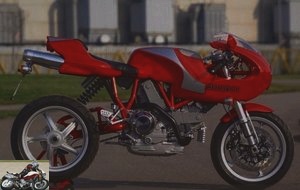 The seat is quite high, including for bikers over 1m80
The seat is quite high, including for bikers over 1m80
In place of the proto’s camera, Ducati installed a pair of mirrors from the 996 and just as useless: you can see nothing but its arms. Moreover, during my test one of the two fell and I then had to remove the second, allowing the bike to gain in style. Since they are useless, I bet a lot of the 2000 motorcycles ended up like this. A fate that must also have known the escapement which provided a rather flat note despite its elegant appearance..
The prototype’s white-faced Veglia-style tachometer, which includes a digital counter underneath, has been retained, as has the hidden kickstand that can only be unfolded when lowered and which encourages leaving the bike in gear for a while. once parked.
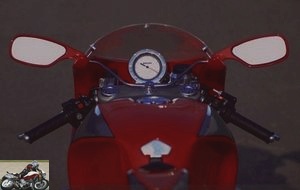 Recovered from the 996, the mirrors do not offer a real view to the rear
Recovered from the 996, the mirrors do not offer a real view to the rear
Test
But once aboard the Hailwood, as everyone calls it at Ducati (Pauline was surely right!), You immediately feel good, with your knees nestled in the cutouts of the "tank", just like on the NCR d origin that I had the opportunity to drive a few times. At first glance, when driving slowly to try to heat up the Michelin Pilot, the MH seems clumsy, with a propensity of the front wheel to try to get into slower corners. But as the tires heat up and everything starts to come together, I realize this is a well-developed package, with surprisingly good suspension tuning and nice ride qualities from the inverted Marzocchi 43 fork. mm not adjustable, but especially of the cantilever shock absorber Paioli offset.
 The suspensions of the MHe are perfectly tuned
The suspensions of the MHe are perfectly tuned
Despite the lack of a link, it is surprisingly flexible, so much so that in my first session I felt better handling than the 900SS, both in terms of chassis geometry and suspension response. . The MHe turns faster and handles very well at higher speeds, with a 24 ° caster angle and 98.5mm caster providing good stability in fast turns, even those with a hump or the bike relatively heavy. for a V-Twin (186 kg dry) only shrugs the shoulders.
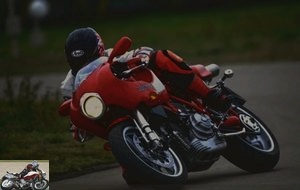 The sportswoman from Bologna is very stable in fast curves
The sportswoman from Bologna is very stable in fast curves
It’s just a shame that it’s so high, as it makes it quite heavy at low speeds, especially through Bologna city center to the famous portico-lined climb that leads to the Basilica of San Luca and to the countryside beyond. And if the ground clearance seems unlimited, I can’t say that I explored the edge of the shoulders of the tires in the potentially very fast corners due to the low temperatures..
Despite the relatively modest design of the four-piston caliper, the Brembo brake package provides a good bite. An emergency stop did not cause the Marzocchi fork to dive excessively. It is actually quite pleasant to drive.
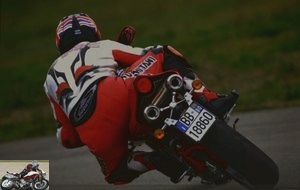 Very classic, the braking provided by Brembo calipers is efficient
Very classic, the braking provided by Brembo calipers is efficient
A key component is the obsolete engine which seems to have been reworked since my last ride on a 900SS 18 months ago. The biggest improvement lies in the gearbox, which is here more precise in the selection and especially with a much lighter action on the clutch lever, much more than on any model of the time: even the neutral is easy to find at rest !
There is good engine response in low revs, without the jerks that we encountered before. This makes driving the MHe on twisty roads all the more rewarding, as you brake late in the turn while waiting for the front tire to return to the road condition, as the Marzocchi entry fork of range, but effective, manages to erase.
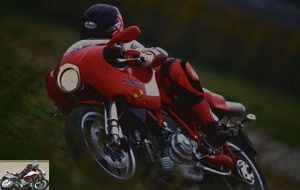 The Desmodue is more flexible and much more pleasant to take on small roads
The Desmodue is more flexible and much more pleasant to take on small roads
The smooth, yet responsive response when throttling out of a corner makes riding the V-Twin’s torque curve even easier than 20 years ago on the MHR 900 Mike Hailwood Replica, making at least one of six superfluous reports.
Conclusion
OK, I’ll admit it: I absolutely didn’t expect the MH900e to be as satisfying to drive as it is thrilling to watch. Aside from its high stance and dull sound, this was a more refreshing and arguably better bike than the 900SS from which it was derived..
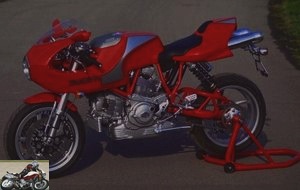 The Ducati MH900e, model 0000/2000
The Ducati MH900e, model 0000/2000
This concept was too good to be left as a limited edition and scrapped after the delivery of the promised 2,000 copies. What Ducati held there, almost unintentionally, was the basis for the new generation 900SS and its outdated sisters in the Sport Classic segment. It was a concept that deserved more than the lucky 2,000 who were in front of their computer screens while we partied on New Years Eve 2000. Unfortunately, this is an opportunity that was rejected by Ducati management: the MH900e is destined to remain one of a kind forever.
Strong points
- Look
- Suspensions
- Smooth motor
- Transmission
Weak points
- Saddle height
- Exhaust sound
- Feverish crutch
- wing mirror
The technical sheet of the Ducati MH900e
Related articles
-
The best, quite simply 998 cc V4, 221 hp (234 hp) and 112 Nm, electronics and ride-by-wire, aerodynamic fairing, 193 kg full facts, 39,900 euros 2019…
-
Ducati 350 SCD motorcycle test
From the circuit to the road for the Italian sportswoman 4-stroke single cylinder, 340 cc, 42 hp, 210 km / h, 112 kg dry In 1954, the arrival of Fabio…
-
Ducati 1098 motorcycle test – 160 hp in free version
There are times in a biker life where the emotional strikes, in the heart ! I remember when the 916 was released : what a slap! A stroke of genius signed…
-
Sports test Ducati 750SS Moreparts
The Desmo of Mike Hailwood’s comeback 90 ° desmo V-Twin, 749 cm3, 73 hp, 180 kg dry Most road racing enthusiasts will tell you that Mike Hailwood did not…
-
Ducati Monster motorcycle test
Salon revolution V-Twin Testastretta of 937 cm3, 111 hp, 93 Nm, 166 kg dry (188 kg full made), 11,290 euros Is a Monster still a Monster if it doesn’t…
-
Ducati 848 motorcycle test – 134 horsepower in free version
The Ducati 848 is the mid-size sports car of the Italian brand, evolution of the 749, halfway between the 696 cm3 of a Monster and the 1198 cm3 of its…
-
The European Grand Prix prototype 108 ° V4, 499 cc, 192 hp at 12,500 rpm, 129 kg We find it normal to see Ducati, KTM and Aprilia currently competing in…
-
A queen who treats you By their personality, their characteristics and their performances, the Ducati have always been motorcycles apart. La Panigale is…
-
Sports test Chevallier Honda RS500
Against all odds V3 at 90 °, 499 cm3, 125 hp, 116 kg dry Beating the Japanese factory teams by winning Grand Prix with motorcycles you yourself built in…
-
Ducati Scrambler Cafe Racer test
A more sporty version of the Scrambler with a neat look The Scrambler V2, 803 cm3, 75 hp at 8,250 rpm, 68 Nm at 5,750 rpm, 172 kilos, € 11,290 About 2000…